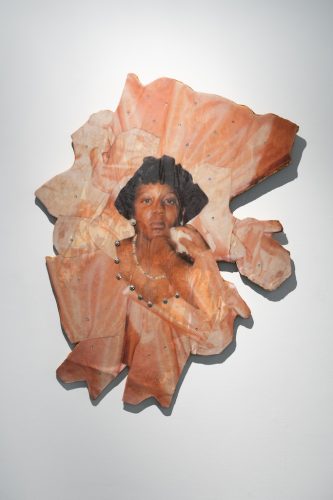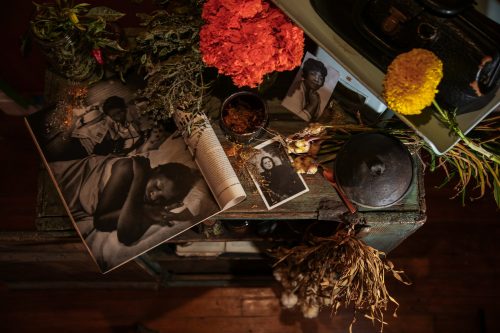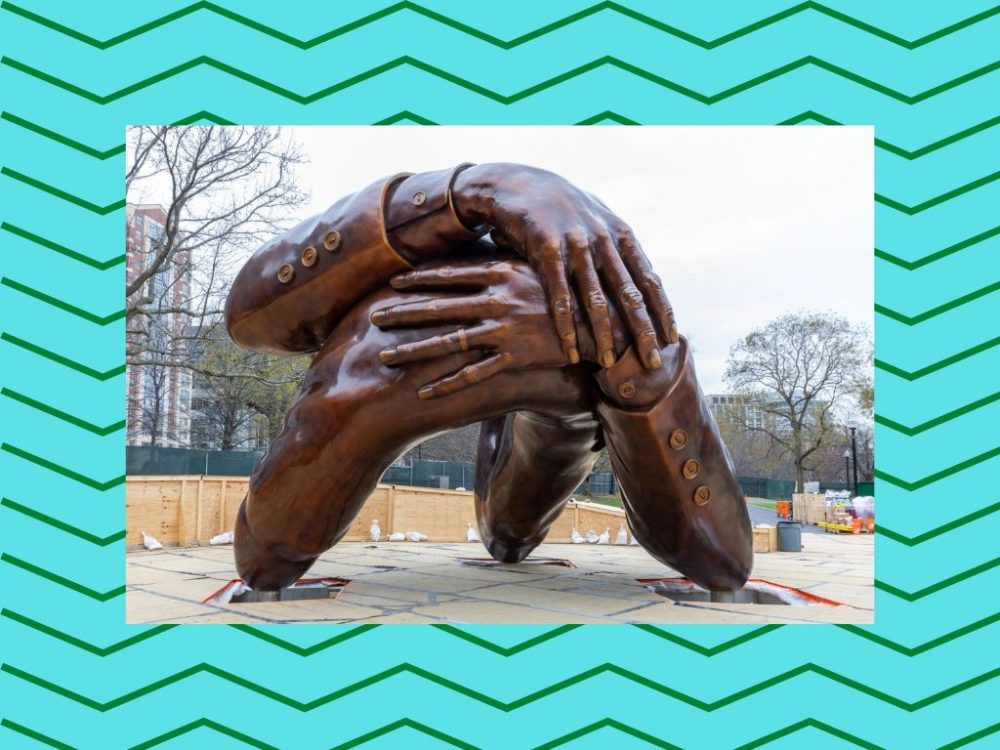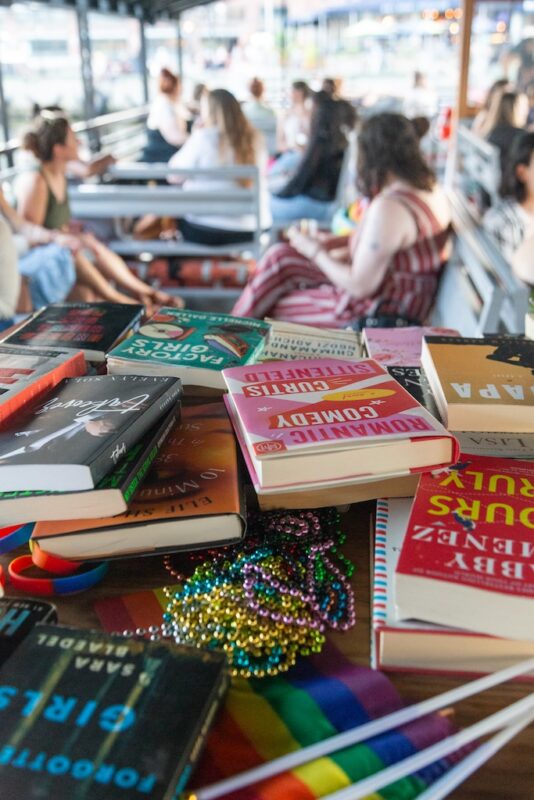This week was all about The Sculpture™. Highlights: The Sculpture™, the power of blond, Mindy Kaling, fat-shaming your girlfriend, jelly time and aspic influencers, climate change is causing animals to give up, tech and media layoffs, and AI chatbots taking the world by storm.
Hyperallergic: A New MLK Sculpture Draws Mixed Reactions
Artist Hank Willis Thomas’s new Martin Luther King Jr. sculpture, ‘The Embrace’, was unveiled in a ceremony in Boston Commons last week. The large public work was “inspired by a photograph of Dr. King embracing his wife Coretta Scott King after winning the Nobel Peace Prize in 1964.”
The 20-foot-tall piece of King and Scott King’s disfigured arms embracing was immediately met with mixed reviews, with people describing it as a “sexual rubik’s cube.” I have to say I agree. Admittedly, I have not seen the piece in person—nor have most of its online critics, which are many—and I understand that could (and would) vastly change how I experience the work, something that Thomas noted in a response to the backlash.
Conceptually, there is a lot to like about Thomas’s approach to the sculpture. I love the inclusion of Scott King, who so often gets left out. I like that people can talk into, under, and around the piece. And I like that (some of) the family likes it— “Martin Luther King III said the monument represents his parents’ love for the city and its abolitionist past, and that it memorializes their relationship.”
Critics have pointed out that “that the affectionate gesture does not call forth King’s history with the FBI’s domestic counterintelligence program (COINTELPRO), his speeches calling out White moderates, or more controversial campaigns like his anti-Vietnam War rallies, for instance,” and “some self-described Black Boston residents who find that the statue does not adequately address ongoing struggles for Black people or modern racial justice organizing.”
‘The Embrace’ isn’t the first public sculpture to face public backlash. In 2011 when Lei Yixin’s monument of King, ‘Stone Hope,’ was unveiled in Washington, DC, its controversy exceeded that of ‘The Embrace.’
The monument, which cost $110 million to make (in comparison to The Embrace which only cost $10 million), faced backlash “even before its completion in 2011, the 30-foot-tall monument had provoked a bitter outcry, with detractors claiming that Lei was the wrong person for the job, that the mode in which he portrayed King was poorly chosen, and that the means by which Lei was to create the piece were problematic. And the furor did not die down once the work finally went on view.”
It will be interesting to see if, and how, reactions to The Embrace might change over time.
New York Times: The Enduring, Invisible Power of Blond
Tressie McMillan Cottom has been talking about the beauty politics of blond for years. Recently, Cottom stitched a video to a TikTok of “a young white American woman with brassy white blond highlights and dark brown roots” refuting a commenter that claimed she wasn’t blonde. The woman “asked her mother whether she was a ‘natural brunette.’ ‘No, you were born blond,’ the mother responded.”
Cottom’s video “reply described the humorous video as an example of a multiyear project I have been working on about ‘blonde’ as a racial signifier. We use “blonde” (and if to a lesser extent ‘brunette’) to signal that someone is white without using a racialized term like ‘white.’ It may also be more—a signifier of a type of white person.”
The causal response resulted in her suspension from the app for a week after “a popular TikTok account appear[ed] to have encouraged its followers to report me en masse, a common online tactic called swarming,” Cottom writes. She continues to argue throughout her column that blond is a status, noting how “when people have outsize emotional reactions to benign inquiries about their self-evident beliefs, it is often an indicator that status is doing invisible work. That makes the culture, economics and politics of blondness great ways to think about how status derives its power and how we use that power in our own lives.”
BuzzFeed: The Mindy Kaling Backlash Has Lost All Nuance
I don’t consume a lot of Midy Kaling’s work. The only thing of hers I follow is HBO’s The Sex Lives of College Girls, a show I generally enjoy. However, after the release of Velma, an “adult version of the Scooby-Doo cartoons,” produced by Kaling and featuring her as the voice of the titular character, she has been dragged up and down the timeline all week. The release of the show “opened up a discourse about Kaling’s long career of writing and performing a specific kind of Indian woman: dorky, self-absorbed, insecure, obsessed with attaining the romantic validation of caustic white guys, and eager to fling herself, her family, her culture, and other cultures under the bus to get it.”
Throughout her work there is a pattern of characters that fits this description ( Mindy Lahiri of The Mindy Project, Devi Vishwakumar from Never Have I Ever, Bela Malhotra in The Sex Lives of College Girls, and now Velma). These characters are transparently Kaling, and “the collapse between [her] on screen personas and actual personhood has fueled the fire of online anger. As the critiques of Kaling’s characters escalate, so too does the demand for Kaling’s accountability.”
As with most online critiques and debates, discussion of Kaling’s career lacked a lot of nuances, but “if we had a better forum for this kind of critical discourse, it might be easier to articulate the reasonable — even boring — consensus at the heart of all this controversy: Kaling has written the same caricature of herself too many times.”
Autostraddle: You Need Help: You Fat-Shamed Your Beautiful Girlfriend
For her advice column, Heather Hogan responded to a writer who told her girlfriend she was less attracted to her after her girlfriend gained weight, asking “How can I revive some of that physical attraction? How can I be less of a fatphobic asshole? And was it wrong for me to be honest about my feelings?”
In professing the question, the writer noted that the weight-gain has caused her girlfriend “distress,” and that she has made attempts to lose/monitor her weight to no avail. The writer is “a self-proclaimed body positive person,” continuing, “I follow fat activists on social media, and I have worked hard to fight the fatphobia I’ve learned throughout my life.” The writer tried to keep her waning attraction to herself, “but we’ve been less intimate lately, and she’s so insecure about her weight gain and is constantly asking me for reassurance about it, which I’ve given. Recently, she asked me straight up if I am less attracted to her now than I was when we first met. I couldn’t lie to her face, and so I said yes.” Now, the writer feels guilty, and seems like they are writing in for absolution.
Hogan, however, offers no absolution, instead declaring from the offset that, “What I’m going to write isn’t going to make you feel very good at all.” Honing in on how the whole letter is about how the writer feels, hardly considering her girlfriend at all, Hogan directly states, “If your girlfriend wrote into this column with this story, I would tell her she should break up with you. Not because you were “honest about your feelings,” but because gaining and losing weight, over and over and over, is part of nearly everyone’s life.”
Through her response, Hogan notes the myriad of things that impact someone’s weight, and the very real social impacts of being fat. She encourages the writer to, “Start with yourself. Work on yourself. I’m not talking about liking photos of fat yogis and body positive quotes on Twitter. I’m talking about trying to really understand what goes into determining a person’s weight, and really seeking knowledge about what it’s like to move through the world as a person who isn’t thin, and most of all unpacking why you’ve responded to your girlfriend the way you have.”
This column went viral, and an editor’s note states they’ve “closed the comments for now to keep Autostraddle’s readers, writers, and editors as safe as we can.” But A LOT of comments were made before they were disabled, and they are worth checking out.
Eater: Jelly Is Ready for Its Redemption Arc
I have always loved jelly. I grew up in the midwest, and Jell-O with whipped cream wasn’t an uncommon dessert in my house. Ambrosia, or as my mother calls, it ‘church lady salad,’ was a common occurrence at various community functions. It wasn’t until I started spending more time with people outside of the midwest that I realized jelly is passé.
During my first year of graduate school, one of my colleagues was obsessed with making weird kinds of jello. Our studios were across from each other, and I got a firsthand look at her various flavor combinations (Baja Blast, ramen), the forms they took, and everyone’s reactions to the “grotesque” jellies. If you’ve ever been privy to the vastness of fluff salads, there are very few things about jelly that are surprising.
For most of the country, however, jelly is having a redemption arc and Ken Albala is one of its leaders. Author of The Great Gelatin Revival, in 2019 Albala “started making and posting creations like a jelly lobster, jellied pho tartare, jelly with lutefisk and clams in an abalone shell, and a relatively tame spiced wine jelly, eventually becoming an ‘aspic influencer,’ as Salon once put it.”
In this interview with Bettina Makalintal, Albala “talk[s] about why jelly is on the come-up, and why more of us might reconsider all things jiggly.”
Undark: In a Famed Kenyan Game Park, the Animals Are Giving Up
Last week I wrote about grasslands, and this week I read about how in Amboseli National Park animals “have chewed every blade of grass down to a beige nub.” Amboseli “spreads out across 151 square miles of plains and marsh, rivers and a seasonal lake,” and is facing its third consecutive year of “a climate change-fueled drought. But this grand national park also sits at the intersection of competing interests between humans and wildlife that are being aggravated by warming temperatures and lack of rain.
Here, on grim display, is a portrait of how climate change exerts pressure on creatures — wild, domesticated, and human — pushing them to clash over resources.” The park is now filled with carcasses, and “creatures, so famous for trying to survive, are giving up.”
Slate: The Justices Don’t Want to Know Who Leaked Dobbs
The report on the Supreme Court leak of the Dobbs decision was released this week, and, unsurprisingly, we still don’t know who did it. Samuel Alito’s majority decision “in Dobbs v. Jackson Women’s Health Organization, which overruled Roe v. Wade,” was leaked nearly two months before it was issued by the court.
Legal reporters Dahlia Lithwick and Mark Joseph Stern discuss the report, with Stern noticing “there’s absolutely no indication that a single justice was interviewed,” and Lithwick asking “Was this an authorized leak? Did a justice leak it or tell someone to leak it?”
The Atlantic: What the Tech and Media Layoffs Are Really Telling Us About the Economy
Every week it seems like some big tech or media company is having massive layoffs. On Friday, “Google’s parent company, Alphabet, today announced that it plans to cut 12,000 jobs, joining a tech-and-media layoff list that already includes Microsoft, Meta, Amazon, Salesforce, Snap, Twitter, and Warner Bros. Discovery. According to one estimate, roughly 130,000 people have been dismissed from their jobs at large tech and media companies in the past 12 months.” This trend, however, is somewhat perplexing as “the overall unemployment rate in the U.S. is 3.5 percent, which ties the lowest mark of the 21st century.”
Derek Thompson explores various possible reasons for this trend, including the weird pandemic economy, inflation rates, interest rates, and “that chief executives are normal people who navigate uncertainty by copying behavior.”
Digital Trends: ChatGPT: how to use the viral AI chatbot that’s taking the world by storm
Since it was released late last year, ChatGPT, developed by OpenAI, has put a lot of people into a frenzy. A “general-purpose chatbot.. [has] become the dominant example of the influence AI-generated content will have in the future, showing just how powerful these tools can be.”
ChatGPT, which costs $3 million a month to run, might be the first program freely available causing controversy, but it surely won’t be the last. Business members of the c-suite are obsessed, white collar workers are scared of losing jobs. Academia is pissed, and schools are banning the program. Kenyan workers and internet users were exploited to make it. Google is panicking. All of the responses above are reasonable, and it will be interesting to see how people personally, and society collectively will navigate these programs—and the ethics of how they are created—in the future.






